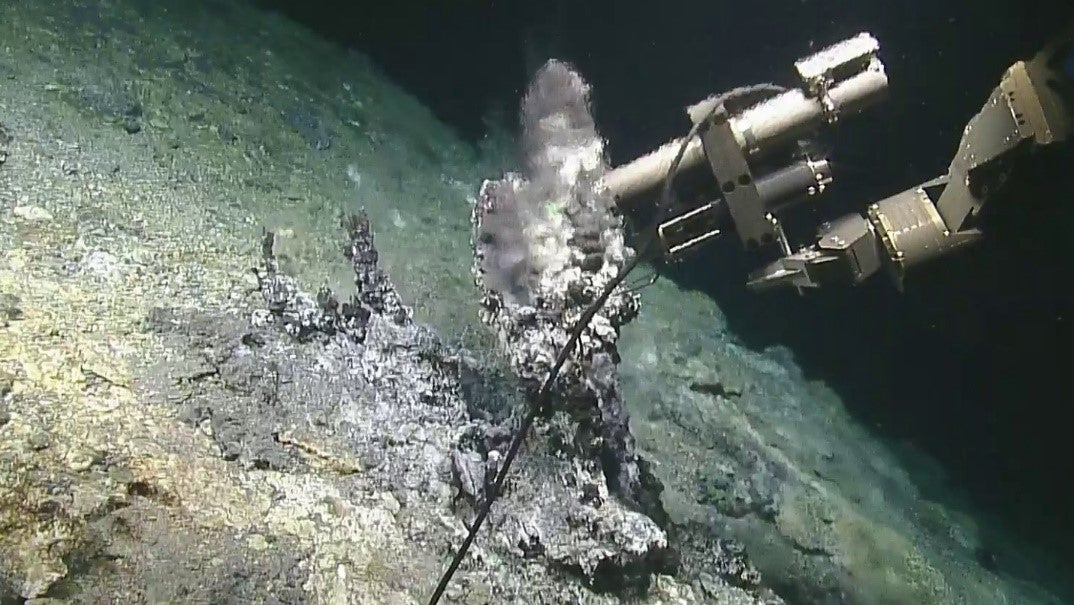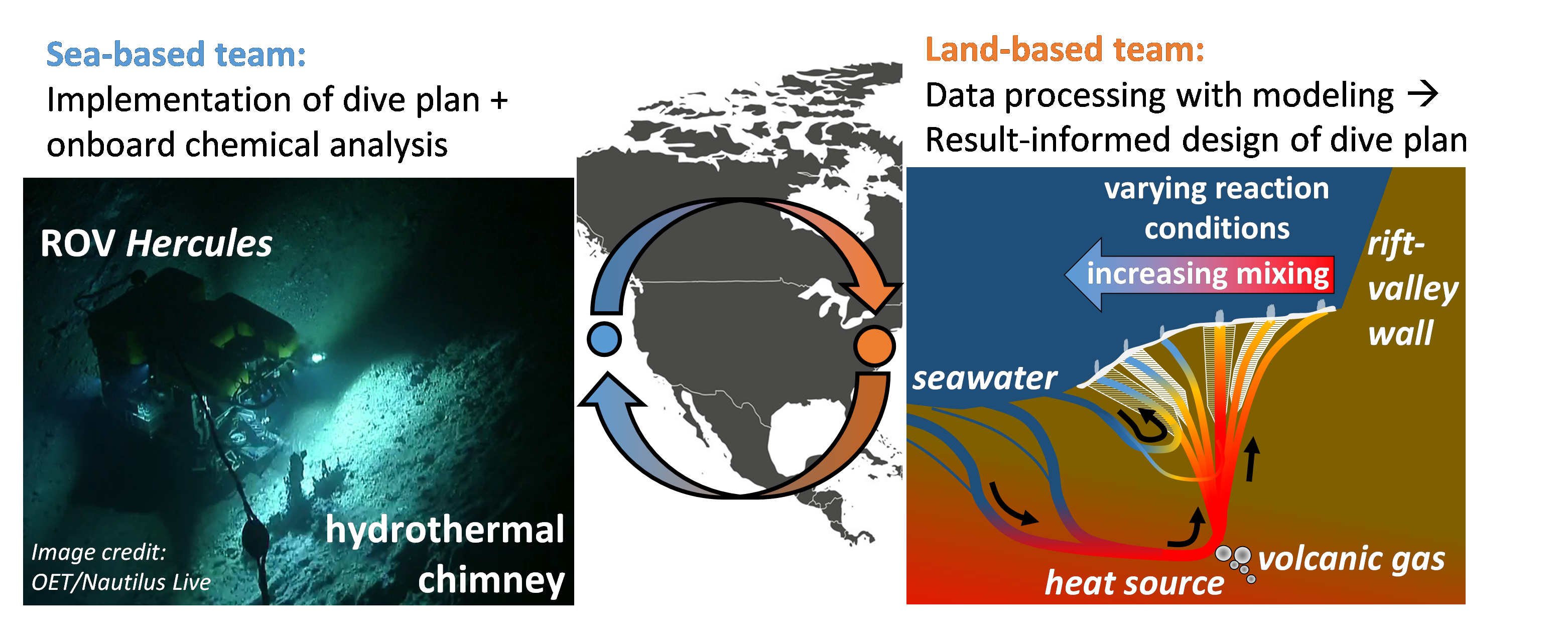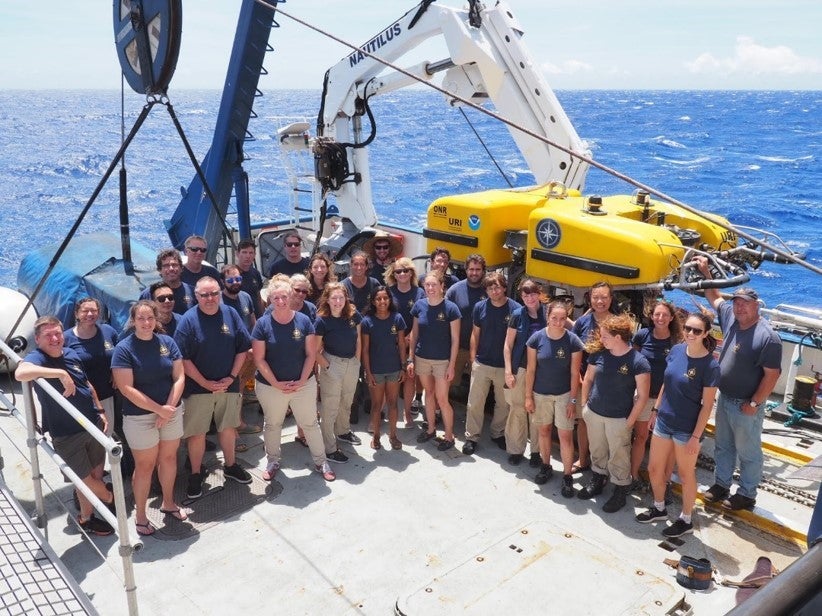Deep-sea exploration breakthrough to guide future space exploration missions

At 2,700 meters below sea level, the remotely operated vehicle Hercules explores the seafloor looking for hydrothermal fluid vents. Credit: Ocean Exploration Trust/Nautilus Live
Editor’s note: This story is featured in the 2021 year in review.
Scientists from Arizona State University, who are a part of the Systematic Underwater Biogeochemical Science and Exploration Analog (SUBSEA) program, have pioneered a new approach to the scientific process of geochemical exploration for our Earth and beyond.
Everett Shock of ASU’s School of Earth and Space Exploration and former ASU postdoctoral scholar Vincent Milesi worked with teams onboard the Ocean Exploration Trust’s (OET) Exploration Vessel Nautilus to use deep-sea exploration on Earth as an analog for hydrothermal systems on other ocean worlds.
In so doing, they designed and tested a new concept of operations that could help change the paradigm of planetary exploration. Their new approach is detailed in a recent article published in the journal Planetary and Space Science.
Current scientific field exploration often involves a multiyear experimental cycle, starting with data and sample collection followed by analyses and modeling that then leads to findings that influence the design of subsequent experimental efforts.
But the ASU researchers exploring deep sea hydrothermal vents as part of the SUBSEA project moved their modeling to the beginning of this process, significantly speeding up their ability to interpret the data from months to a couple of hours.

Hydrothermal fluids produced at depth from the interactions of seawater with hot rocks vent out of chimneys made of mineral precipitates. Credit Ocean Exploration Trust/Nautilus Live
The novelty of their approach is to use programming languages to automate the multiple runs and data processing of geochemical calculations in order to analyze a large range of possible reaction conditions that generate vent fluids before and during their deep-sea investigations.
“The strength of this approach is that it makes it possible to be surprised when the predictions of the model are confirmed or disproved during exploration” said Milesi, lead author. “On cruise missions, on-board ship analyses can now be interpreted with the modeling as the expedition proceeds, rather than having to wait months for the analytical results to come back from the lab and then start the modeling effort.”
The team tested their new procedure during the exploration of the “Sea Cliff” hydrothermal vent field on the Gorda Ridge in the northeast Pacific Ocean. They began by conducting a series of reaction-path calculations before the expedition to predict the diversity of possible fluid chemical compositions and energy available for microorganisms at the vent site.
Then, during the expedition, ship-based chemical analyses of collected vent samples were sent to a shore-based team of geochemical modelers, who compared the measured and forward-modeled data to determine the reaction conditions at the origin of the vent fluids at depth.

A model of the new exploration paradigm developed during the 2019 SUBSEA expedition to the Gorda Ridge. During the expedition, the results of on-board ship analyses of hydrothermal vent fluid samples were sent to the land-based team at the Inner Space Center at the University of Rhode Island to be compared with the results of geochemical modeling. The outcomes were then used to inform the design of the dive plan. Credit: Milesi et al.
These comparisons then informed, in real time, the design of the dive and sampling plans during the expedition, as well as providing a guide for future expeditions. Rapid hypothesis testing also freed up time for further exploration resulting in the discovery of a nearby hydrothermal vent field named Apollo by the SUBSEA group in honor of the 50th anniversary of the first moon landing by astronauts.
“Geochemical modeling used to be what you did once you had all your data, but no more,” said Shock, study co-author.
And this new approach to the scientific process is particularly important to the field of astrobiology. In the search for life on other planets, scientists are looking to gain an understanding of what kind of water-rock interactions occur on icy moons (like Enceladus, one of Saturn’s moons) and whether they support microbial life. To answer that question, scientists have to optimize their exploration and sampling strategy to learn the most about the habitability of these extreme environments.

The SUBSEA team exploring seafloor hydrothermal vent fields as analogs of ocean worlds. Credit: Ocean Exploration Trust/Nautilus Live
“It would be unfortunate to realize years after a mission was complete that a sample collected just a few meters farther away or with a slightly higher temperature would have had much more to tell than the fluid that was sampled,” Milesi said. “Our new process of analysis as the expedition proceeds is particularly critical for space exploration, where costs are high and time is of the essence.”
Deep-sea research as analog for deep space
Ocean and space research have a lot in common. In both fields, robotic explorers are sent to work where humans cannot easily go, with input from groups of people both relatively nearby and much farther afield. Combining the two worlds allows the SUBSEA team, led by Darlene Lim of NASA’s Ames Research Center, in California’s Silicon Valley, to help prepare for new types of space exploration missions by practicing now under realistic conditions on Earth.
The SUBSEA team has been conducting scientific investigations to help NASA better understand the potential that other ocean worlds could have to support life, while also studying the oceanographic exploration process as a way to understand how to conduct remote science missions and to streamline future exploration.
The team was able to leverage ship-to-shore telepresence technologies developed over the past decade by OET and augmented by NASA technologies for this expedition to expand the size of the science team to a multidisciplinary team of researchers on shore. The work conducted by the SUBSEA team has direct implications for near-term human exploration destinations like the moon and Mars.
SUBSEA is funded by NASA and the National Oceanic and Atmospheric Administration’s Office of Ocean Exploration and Research. Additional co-authors and contributors of this study include Tucker Ely of ASU, Megan Lubetkin of the Ocean Exploration Trust, Sean Sylva, Julie Huber, Amy Smith, Christopher German of the Woods Hole Oceanographic Institution, Shannon Kobs Nawotniak of Idaho State University, Zara Mirmalek of Harvard and the Bay Area Environmental Research Institute, and Darlene Lim of NASA Ames Research Center.
More Science and technology

ASU professor honored with prestigious award for being a cybersecurity trailblazer
At first, he thought it was a drill.On Sept. 11, 2001, Gail-Joon Ahn sat in a conference room in Fort Meade, Maryland.…

Training stellar students to secure semiconductors
In the wetlands of King’s Bay, Georgia, the sail of a nuclear-powered Trident II Submarine laden with sophisticated computer…

ASU startup Crystal Sonic wins Natcast pitch competition
Crystal Sonic, an Arizona State University startup, won first place and $25,000 at the 2024 Natcast Startup Pitch Competition at…